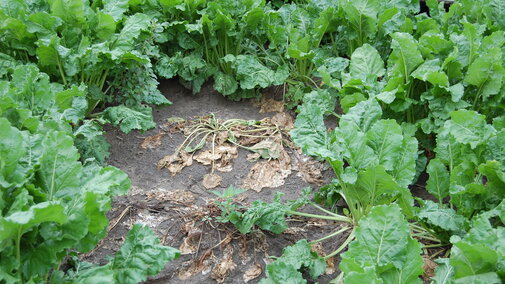This is the first article in a series on distinct sugarbeet root rot diseases caused by the genus Rhizoctonia. It is an introduction to the different root rot diseases induced by three species of Rhizoctonia, two of which are relatively obscure and largely unknown.
Sugarbeets are susceptible to many root rot diseases, which traditionally are one of the major factors limiting profitable production wherever beets have been grown. They include rhizomania, Rhizoctonia root and crown rot, Fusarium wilt, Aphanomyces root rot, and cyst nematode.
These diseases were largely responsible for the gypsy-like existence of the fledgling sugarbeet industry the U.S. in the early 20th century. It was common for factories to become established, run a few years, and then fail because recurrent disease outbreaks resulted in crop failure or roots of such low quality as to be unprofitable. Factories would then be moved to another location where production would be more stable.
In contrast to foliar diseases, root diseases induced by soilborne pathogens often cause more serious losses because they are difficult to detect before substantial damage occurs.
In the mid-1800s, as knowledge of microorganisms began to improve, soilborne diseases became better understood and economically important in European crop production, particularly those caused by the sugarbeet cyst nematode and Rhizoctonia.
Today the genus Rhizoctonia is comprised of a group of sterile fungi that are highly variable, yet still share similar characteristics, namely they remain vegetative, rarely producing any reproductive spores. Rhizoctonia species are effective saprophytes, and are capable of surviving in soils for long times; however, they also include several economically important root pathogens that routinely cause serious disease problems to numerous crop species.
In fact, the generic name, Rhizoctonia, is derived from the Greek language, translating into English as “killer of roots” due to the fact that this fungus rapidly attacks and kills the roots of its host plants.
In Nebraska sugarbeets have periodically suffered substantial economic damage over the years from three separate root-rot diseases, caused by three distinct species of Rhizoctonia.
Rhizoctonia root and crown rot, caused by Rhizoctonia solani, is the disease likely familiar to anyone who works in any phase of sugarbeet production. It has been the most widespread and consistently damaging disease in Nebraska, making it arguably the most important disease.
The other two diseases are much rarer in occurrence. Rhizoctonia crocorum causes a disease of sugarbeets and numerous other root crops called violet root rot. The name is derived from the thick reddish purple fungal mycelial growth produced on taproots as it infects the plants. Another even more uncommon disease of sugar beets is called dry rot canker. It is caused by a completely different species of Rhizoctonia referred to as “binucleate.”
Over the next few months the stories for each of these diverse Rhizoctonia diseases will be expanded and explained as a part of the Panhandle Perspectives series.

